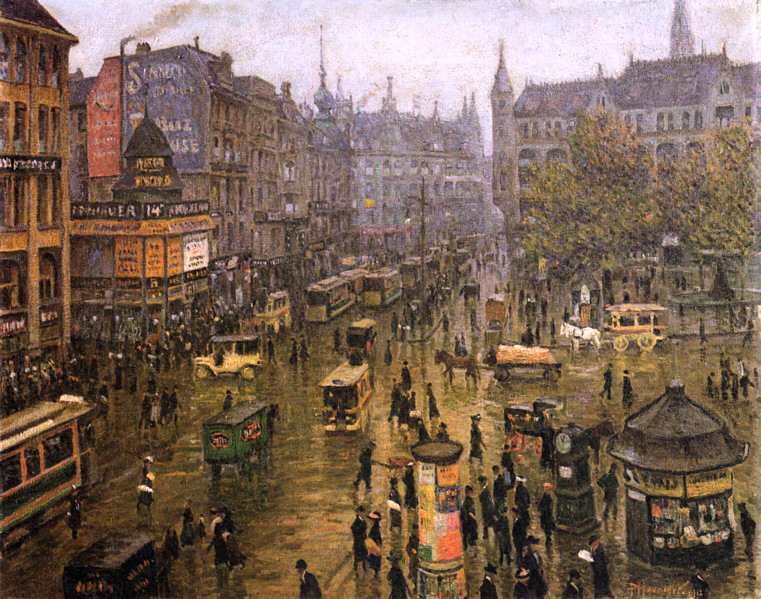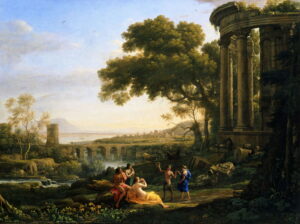Urban Revolutionaries: 11 Crowds and traffic

As more people were drawn from the surrounding countryside to populate growing towns and cities, the density of people within them rose. Accommodation became crowded, the streets were often full of people, and vehicle traffic threatened the safety of pedestrians.
The people that cities thrived on for their labour force were also its greatest threat. Outbreaks of infectious disease were common: in London, over fourteen thousand died from cholera in 1849, and a further ten thousand in 1853. From the middle of the nineteenth century, cities across Europe improved their sanitation and water-borne diseases became infrequent. The biggest killer of young adults remained ‘King Death’, tuberculosis, which spreads well in densely populated urban areas, and there were also local outbreaks of diseases like smallpox.
Adolph Menzel (1815–1905), Afternoon in the Tuileries Gardens (1867), oil on canvas, 49 x 70 cm, The National Gallery, London. Courtesy of National Gallery (CC), via Wikimedia Commons.
Extensive redevelopment of central Paris retained many of its open spaces, although in fine weather these got crowded, as shown in Adolph Menzel’s Afternoon in the Tuileries Gardens from 1867. This appears to have been painted in homage to Manet’s Music in the Tuileries of 1862.
Lesser Ury (1861–1931), Leipziger Straße (1889), oil on canvas, dimensions not known, Berlinische Galerie, Berlin, Germany. Wikimedia Commons.
Many cities were just as crowded at night, as seen in Lesser Ury’s view of Leipziger Straße in Berlin, painted in 1889. Although street lighting was becoming increasingly common, it was inadequate for this hazardous mixture of electric trams (introduced in 1881), horse-drawn carriages and pedestrians. Accidents were frequent, and deaths not uncommon.
Léon Augustin Lhermitte (1844–1925), Les Halles (1895), oil on canvas, dimensions not known, Petit Palais, Paris. Wikimedia Commons.
City markets such as Les Halles, the central market in Paris, depicted here by Léon Augustin Lhermitte in 1895, were packed with buyers and sellers for much of the day, as described by Émile Zola in his novel Le Ventre de Paris (1873).
Painting the crowded city streets was a challenge mastered by few, including Camille Pissarro for Paris and Colin Campbell Cooper for New York.
Camille Pissarro (1830–1903), Boulevard Montmartre, Spring (1897), oil on canvas, 65 x 81 cm, Private collection. Wikimedia Commons.
Pissarro’s Boulevard Montmartre, Spring from 1897 is a landscape composed primarily of buildings and streets, a plethora of figures, and countless carriages to move those people around.
Camille Pissarro (1830–1903), The Pont-Neuf (1902), oil on canvas, 55 x 46.5 cm, Szépművészeti Múzeum, Budapest, Hungary. Wikimedia Commons.
In 1902, just a year before his death, Pissarro painted this amazing view of crowds on The Pont-Neuf bridge in Paris.
Colin Campbell Cooper (1856–1937), The Rush Hour, New York City (c 1900), further details not known. Wikimedia Commons.
In Cooper’s The Rush Hour, New York City from about 1900, the canvas is literally teeming with people, who are pouring along the street, packing the stairways and walkways to a station, and seething around booths and tramcars.
Colin Campbell Cooper (1856–1937), The Ferries, New York (c 1905), other details not known. Wikimedia Commons.
Cooper followed those crowds onto The Ferries, New York (c 1905), where they are as densely packed as they were in The Rush Hour above.
Colin Campbell Cooper (1856–1937), Broadway from the Post Office (Wall Street) (c 1909), oil on canvas, 130.5 x 89.9 cm, City of Santa Barbara, Santa Barbara, CA. Wikimedia Commons.
Cooper’s Broadway from the Post Office (Wall Street) (c 1909) is one of his most famous skyscraper cityscapes. This shows the Singer Building or Tower, at Liberty Street and Broadway, that had only just been completed, and was still the tallest building in the world. Below in Broadway itself the street is packed with people.
George Bellows (1882–1925), New York (1911), oil on canvas, 106.7 × 152.4 cm, The National Gallery of Art, Washington, DC. Wikimedia Commons.
George Bellows’ New York (1911) has a human horizon of figures walking past a white background, dividing the canvas into two. Above is a vague blur of buildings, below a cacophony of vehicles, stalls, and people.
Among the immigrants to arrive in New York City from Italy in 1896 was Giuseppe Michele Stella. Born in the small town of Muro Lucano, with a population of about ten thousand, he changed his name to Joseph, abandoned his medical studies, and became a painter of international renown. The shock of living and working among those crowds must have run deep, and between 1909-11 he had to return to Italy to recover.
Paul Hoeniger (1865–1924), Spittelmarkt (1912), media and dimensions not known, Stiftung Stadtmuseum Berlin, Berlin. Wikimedia Commons.
Berlin’s Spittelmarkt, painted here by Paul Hoeniger in 1912, mixes early motor cars, horse-drawn wagons, trams, and people walking in every direction, all without any road markings or traffic controls.
Maximilien Luce (1858–1941), The Gare de l’Est in Snow (1917), oil on canvas, 130 x 162 cm, Musée de l’Hôtel-Dieu, Mantes-la-Jolie, France. Wikimedia Commons.
Winter weather was no deterrent either, as Maximilien Luce demonstrates in his painting of The Gare de l’Est in Snow from 1917.



